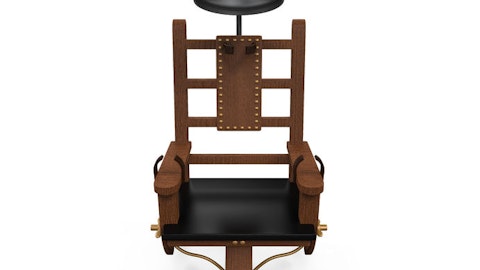Bobby Griffin : And then Bob, I think, you touched on it a little bit in your remarks about improving the efficiency, but just any color on kind of where we are versus historical efficiency on a output per employee or any type of metrics you guys look at that kind of help us think about this sequentially building, because I believe that is probably one of the biggest drivers of getting wholesale margins back to double digits, right?
Bob Lucian: It is and it is a combination of the productivity as well as like the decision that we just made. We should get at least 50 to 60 basis points of improvement next year versus this year due to that the restructure that we just announced. Again, it’s not going to start until next year because it’s going to take three months or six months for us to go off and get completed — it’ll be completed by the beginning of fiscal ‘25. It’s going to be that couple — there’s no one single, it’s not just a worker productivity piece of it. There’s work that we’re doing relative to how we are scheduling our plants, what products are being made in our plants. We’re doing work on our delivery expense and our delivery network and how we do that.
So we are tackling every single aspect of our supply chain cost structure via program we call transform. And that program is turning over every rock making improvements in a number of different areas. So, it’s hard to quantify just one thing for you to say, okay, our productivity is so many sofas per shift for whatever, and then it’s going to be up by 10% and that kind of thing. I don’t know if that’s what you were looking for or not.
Bobby Griffin : The basis point improvement based on restructuring is helpful too. And I guess the last side of things is, what is the change do from a capacity standpoint? Hopefully, one day, we are going to get back to a point where industry is growing again. I am hopeful that’s going to happen sometime. But what does it do from a a capacity standpoint, if we get back into a nice type of recovery?
Melinda Whittington: Our focus is absolutely making sure we can service those incoming order rates. And to your point, eventually, there is going to be a tailwind here, on top of all the good work to drive demand. And so, that’s part of our overall equation is to make sure we have got the headroom for when we see order rates pick back up significantly. And importantly, our supply chain will remain agile. So over time, the potential for expansion of our existing Same footprint is something we are always looking at to make sure not just that we have got enough capacity, but that it is in the right locations. Furniture are big pieces to move around, so you want to make sure that, footprint is in the right place relative to where your customer base is too.
Bobby Griffin : And then congrats on getting the agreement to acquire the six Midwest stores. Are the conversations changed any or happening more frequently with some of the independent galleries, given some of the headwinds the industry has been facing or is it still kind of as we have always talked about historically kind of ebb-and-flow basis of timing you can’t really predict?
Melinda Whittington: We have talked over the last couple of years about being a little more strategic in those conversations on our end, rather than kind of waiting to see if someone knocks on the door, making sure we are proactively. Partnering with our long-term independent furniture gallery owners so that they know we are here, if they are interested and what that would look like for them financially. So we have been definitely more strategic in those conversations in recent years. I wouldn’t say anything given the economy is really changing right now. Simply, for the most part, La-Z-Boy Furniture, as you saw in the results the last couple of quarters La-Z-Boy Furniture Galleries broadly are performing well on the strength of the brand and the product offerings. And so you are not seeing that like you might see mom and pops that are general dealer type selling a lot of different brands struggling more.
Operator: Thank you very much. We don’t appear to have any further questions in the queue. I will now hand back over to the management team for their closing comments.
Mark Becks: Thanks, Genie. Melinda, Bob and I will be in our office to take any follow-up questions we didn’t get to on the call. Have a great day.
Operator: Thank you very much everyone. This does conclude today’s conference call. You may disconnect your phone lines at this time and have a wonderful day. Thank you for your participation.
Follow La-Z-Boy Inc (NYSE:LZB)
Follow La-Z-Boy Inc (NYSE:LZB)
Receive real-time insider trading and news alerts




